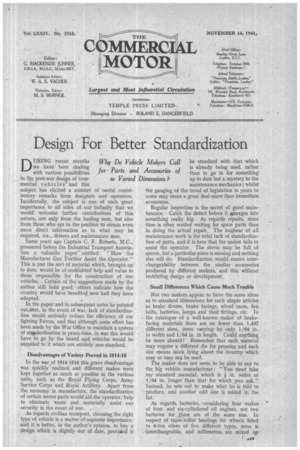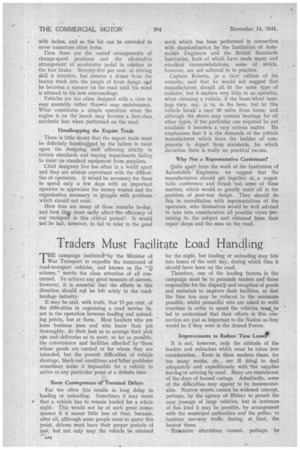Design For Better Standardization
Page 15

Page 16

If you've noticed an error in this article please click here to report it so we can fix it.
• Why Do Vehicle Makers Call for Parts and Accessories of so Varied Dimensions? DURING recent months we have been dealing with various possibilities in the post-war design of commercial vehicle sand this subject has elicited a number of useful contributory remarks from designers and operators. Incidentally, the subject is one of such great importance to all sides of our -industry that we would welcome further contributions of this nature, not only from the leading men, but also from those who are in the position to obtain even more direct information as to what may be required, viz., drivers and maintenance men.
Some years ago Captain C. F. Roberts, M.C., presented before the Industrial Transport Association a valuable paperentitled: "How the Manufacturer Can Further Assist the Operator." This is just the sort of material which, brought-up to date, would be of undoubted help and value to those responsible for the construction of our. vehicles. . Certain of the suggestions made by the author still hold good; others indicate how the country would have benefited now had they been adopted.
In the paper and in,subsequent notes be pointed outthat, in the event of war, lack of standardization would seriously reduce the efficiency of our fighting Forces, and that although some effort has been made by the War Office to maintain a system of stapdardization in peace-time, in war this would have to go by the board and vehicles would be supplied to it which areentirely non-standard.
Disadvantages of Variety Proved in 1914-18 In the war of 1914-1918 this grave disadvantage was quickly 'realized, and different makes were kept together as much as possible in the various units, such as the Royal Flying Corps, Army Service Corps and Royal Artillery. Apart from the economy in manufacture, the standardization of certain motor parts would aid the operator, help to eliminate waste and materially assist our security in the event of war. ,..
As regards civilian transport, choosing the right type of vehicle is a matter of supreme importance, and it is better, in the author's opinion, to buy a design which is slightly out of date, provided it be standard with that which is already being used, rather -than to go• in for something' up to date but a mystery to the maintenance mechanics; whilst the gauging of the trend of legislation in years to come may mean a great deal more than immediate economies.
Regular inspection is the secret of good maintenance. Catch the defect before it emerges into something really big. As regards• repairs, more time is often wasted waiting for spare parts than in doing the actual repair. The bugbear of all maintenance work is the total lack of standardization of parts, and it is here that the maker fails to assist the operator. The stores may be full of spares, but a particular piece is missing and nothing else will do. Standardization would ensure interchangeability between the similar accessories produced by different makers, and this without restricting design or development.
Small Differences Which Cause Much Trouble Not two makers appear to have the same ideas as to _standard dimensions for such simple articles as brake drums, brake facings, wheel races, fan belts, batteries, lamps and their fittings, etc. In the catalogue of a well-known maker of brakefacing materials there are no fewer than 1,437 different sizes, some varyingby only 1/64 in. in width' and 1/64 in. in length. Could anything be more absurd? Remember that each material may require a different die for pressing and each size means stock lying about the Eountry which may or may not be used.
The maker does not seem to be able to say to the big vehicle manufacturer: "You must take my standard material, Which is in. wider or 1/64 in. longer than that for which, you ask." Instead, he sets out to make what he is told to produce, and another odd size is added to the list.
As regards batteries, -considering four makes of fourand six-cylindered oil engines, not two batteries for these are of the same size. In respect of taper-roller bearings for wheels fitted to 6-ton oilers of five different types, none is interchangeable, and millimetres are mixed up with inches, and so the list can be extended to cover numerous other items.
Then there are the varied arrangements of change-speed positions and the alternative arrangement of accelerator pedal in relation to the foot brake. Seventy-five per cent of driving skill is intuition, but remove a drixer from the beaten track into the jungle of fresh design ad he becomes a menace on the road until his mind is attuned to his new surroundings.
Vehicles are too often designed with a view to easy assembly rather that-tato easy maintenance. What constitutes a simple operation when the• engine is on the bench may become a first-class acrobatic feat when performed on the road.
Handicapping the Export Trade There is little doubt that the export trade must be definitely handicabped by the failure to insist upon the designing staff adhering strictly to certain standards and buying departments failing to insist on standard equipment from suppliers. Chief designers live too often in a ;world apart and they are seldom conversant with the difficulties of operators. It wOuld be necessary for them to spend only a few days with an important operator to appreciate the Money wasted and the organization necessary to -grapple with 'problems which should not exist.
How true are many of these remarks to-day, and how thy must sadly affect the efficiency of our transport in this critical period? It would not be fair, however, to fail to refeito the good work which has been performed in connection with standardization by the Institution of Automobile Engineers and the British. Standards Institution, both of which have made many and excellent recommendations, some of which, however, are not adhered to in practice.
Captain Roberts, in a later edition of his remarks, said that he would not suggest that manufacturers should all. fit the same type of radiator, but it matters very little to an operator, when choosing a vehicle, if the front-wheel bearings vary, say, -11Ain. in the bore, but let this vehicle break' a race" 50 miles from home, and although the stores may contain bearings for all other types, if the particular one required be not available it becomes a very serious matter. He emphasizes that it is the demands of the vehicle manufacturer which force the builder of components to depart from standards, for which deviation there is really no practical excuse.
Why Not a Representative Conference?
Quite apart from the work of the 'Institution of Automobile' Engineers, we suggest that the manufacturers should get together at, a roundtable conference and thrash out some of these matters, which would so greatly assist all in the problem of post-war design. They should do this in consultation with representatives of the operators, .who themselves would be well advised to take into consideration all possible views pertaining to the subject and obtained from their repair shops and the men on the road.
























































